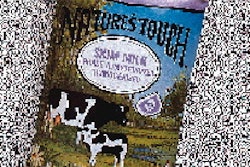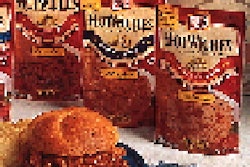In 1897, 28 years after the company was founded, chemist John T. Dorrance joined his uncle's firm and came up with the idea of condensed soups: one of the early instances in which food scientists and packaging technicians worked together on a new food product. Dorrance's condensed soup-in-a-can became so popular that by 1922, the company adopted "Soup" as its middle name.
In 1936, the company started producing its own cans. Campbell remains one of the giants in the food can production business-and one of the last food processors to make its own cans. How much longer that continues remains to be seen.
There are rumblings that Campbell, if not abandoning the metal can as a packaging option, is thinking about exiting the canmaking business. By this time next year, Campbell soups will most assuredly be packaged in cans made by someone else.
But, even if the company stops making cans, it certainly is not going to abandon the fabled "Red and White" labels.
Next year, as it celebrates the 100th anniversary of the development of condensed soups and the 61st year of self-manufacturing of cans, Campbell may, at last, shake off its single-dimension, soup-in-a-can image.
Recent packaging introductions coming out of Camden suggest the company is aggressively looking for packages that appeal to a new generation of consumers with neither the time, the patience, the know-how, nor the need to prepare "scratch" meals.
In March, Campbell arguably became the first packer in the U.S. to pack a tomato-based juice in hot-filled bottles of polyethylene terephthalate. There's still a lot of canned V8 on the market, but it may only be a matter of time before the bottle's advantages of product visibility, handling ease, resealability and cleanliness replace the can.
Last month, Packaging World reported the introduction of the Joseph Campbell line of soups in glass jars (see PW, Nov. '96, p. 9). No one is suggesting that glass jars will replace metal cans for all of Campbell's soups. But, the appearance of no-tool opening, resealable containers that attractively showcase their contents does underscore the point that Campbell product managers are under no pressure to keep the Campbell can lines cranking. They are under pressure to bolster flagging "commodity" soup sales. The proprietary "signature" glass jar being used for the new soup line is just one can alternative on the Campbell Soup drawing boards.
No one is watching the introduction by Stockpot Soups (Redmond, WA) of condensed soups in refrigerated stand-up pouches (see PW, May '96, p.88) closer than Campbell. If Stockpot's flexible pouches help themselves to anything more than a small taste of the condensed soup market, Campbell will retaliate with one or two lightweight refrigerated soup packages of its own.
The company knows the appeal of other container forms. It uses them for the cornucopia of products it produces: Foil-laminated and embossed papers and set-up boxes for its Godiva chocolates, tin-tied paper bags with nesting soufflé cups for its Pepperidge Farm cookies, clear, film-wrapped thermoformed trays for its fresh mushrooms and glass jars for its Vlasic pickles and Prego pasta sauces, and molded fiber trays for its microwaveable frozen entrees. And that's only a portion of the Campbell menu.
What's kept the can on Campbell's specification list is not the Campbell Soup can plant next door. It's the economics of cans and the efficiency of canning lines. But a low-cost container that merely gets product to the shelf will ultimately lose out to a higher-cost package that puts the product into the hands of the consumer.
Campbell does deserve credit for perceptively monitoring consumer packaging trends. Years ago, the company was the first to adopt ovenable paperboard trays for frozen meals. It has packed juices in composite cans and soups in several different types of microwavable bowls. Campbell put portability high on its packaging specification list so working parents and latchkey kids could carry something from Campbell's to eat at work or school. Today opening/reclosing ease is one of Campbell's primary packaging pushes. The V8 bottles, the soup jars, and Campbell's newest, Swanson's chicken broth in snap-cap resealable 32-ounce aseptic cartons from Tetra Pak, Inc. (Chicago, IL) all are designed for toolless opening and simple reclosure.
Demographers today tell us the average American family at most eats three or four meals a week together. In an earlier generation, Campbell made TV DinnersTM a household name. Could a line of Computer Monitor meals be in the works? If so, Campbell will have figured out how consumers can keep their fingers on their keyboards and still satisfy their appetites. Recognizing a growing consumer concern about diets and the growing popularity of catalog sales, Campbell will be introducing a line of low fat, low-cholesterol mail-order frozen meals in the next few months. Cans are not part of the package offering.
Ben Miyares is editor and publisher of the newsletter Packaging Management. He may be reached at 31408 Narragansett Lane, Bay Village, OH 44140. Telephone: 216/892-0998; Fax: 216/892-0208; e-mail: [email protected].






















